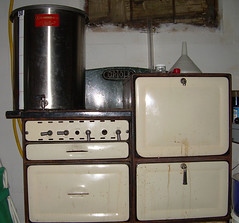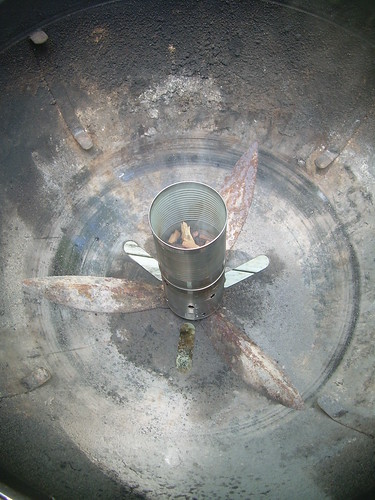 A couple weeks ago, I had another Father's Day! My wife entertained the kid while I brewed a soon-to-be-sampled batch of my English-style ale. I brew on a circa 1920's cast iron Oriole stove in a 50 liter stainless steel pot I bought from Italy. It's a nice combination of brew equipment.
A couple weeks ago, I had another Father's Day! My wife entertained the kid while I brewed a soon-to-be-sampled batch of my English-style ale. I brew on a circa 1920's cast iron Oriole stove in a 50 liter stainless steel pot I bought from Italy. It's a nice combination of brew equipment.
The fermentation went swell starting at an original gravity of 1.052 and ending with a crisp 1.010 for an alcohol content about 5.5% by volume. I kegged it up, dropped about 20 psi CO2 on the headspace and I think it's almost ready for tasting. All that's needed is for the CO2 to finish dissolving into the brew and for clarification and it's finally ready. It's the maiden voyage brew in the new home.
If it tastes good, I'll be inviting some fellow food bloggers for a taste soon. Watch your email.
7.21.2007
Ramming Speed
7.01.2007
Cold Smoking: The Heat Source
 One requirement for cold smoking is a constant source of low heat to smolder wood. This is most commonly achieved using a hot plate and pan with wood chips in it. But, it's energy intensive and requires an outlet outside for the duration of smoking.
One requirement for cold smoking is a constant source of low heat to smolder wood. This is most commonly achieved using a hot plate and pan with wood chips in it. But, it's energy intensive and requires an outlet outside for the duration of smoking.
I wondered if a kerosene tealight (or paraffin) would do the trick. This could be placed inside a can (with ventilation holes) and on top of that can, wood chips in another can. I tried this using a citronella/kerosene tealight (I wouldn't use this in the future because of the citronella, but for proof of principle). The piggy-backed cans were placed inside my funky Weber-Kettle mod and voila! Within minutes, it was filled with mesquite smoke. And barely any heat generated. Since these little tealights can go for 12-18 hours, it should be a convenient source of fuel.
The big question, which will have to be tested on a piece of real food is: Does the food acquire any flavor from the burning kerosene? I suspect, since the kerosene is well contained in these tealights and if the combustion of it in the wick is complete, all the flavor should come from the choice of wood used for smoldering.




